An Analysis of Cultural Safety in Indigenous Education (EEP400)
VerifiedAdded on 2023/04/11
|15
|2772
|239
Essay
AI Summary
This essay critically analyzes the concept of cultural safety within Indigenous education, drawing on the article by Bin-Sallik (2003) and other relevant literature. The essay explores the development of Indigenous higher education, the importance of cultural safety for Indigenous children and families in early childhood settings, and the benefits of creating culturally safe learning environments. It discusses strategies such as school leadership, curriculum quality, and family involvement, and how these align with the Early Years Learning Framework (EYLF). The paper highlights the need for respect, shared knowledge, and the empowerment of Indigenous communities. Furthermore, the essay outlines how these strategies can be implemented to enhance the educational experiences and outcomes for Indigenous students and families, ultimately contributing to their social and spiritual well-being.
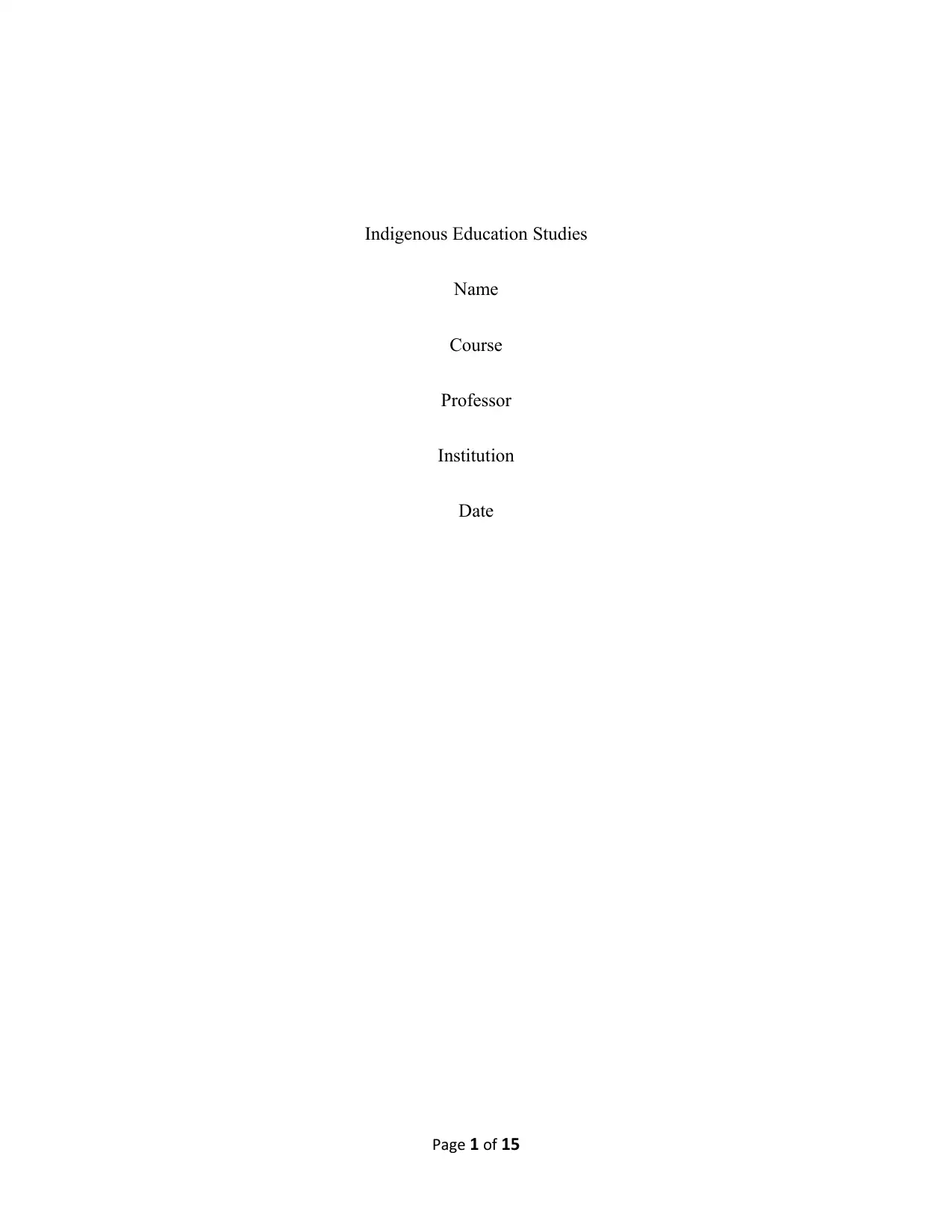
Indigenous Education Studies
Name
Course
Professor
Institution
Date
Page 1 of 15
Name
Course
Professor
Institution
Date
Page 1 of 15
Paraphrase This Document
Need a fresh take? Get an instant paraphrase of this document with our AI Paraphraser
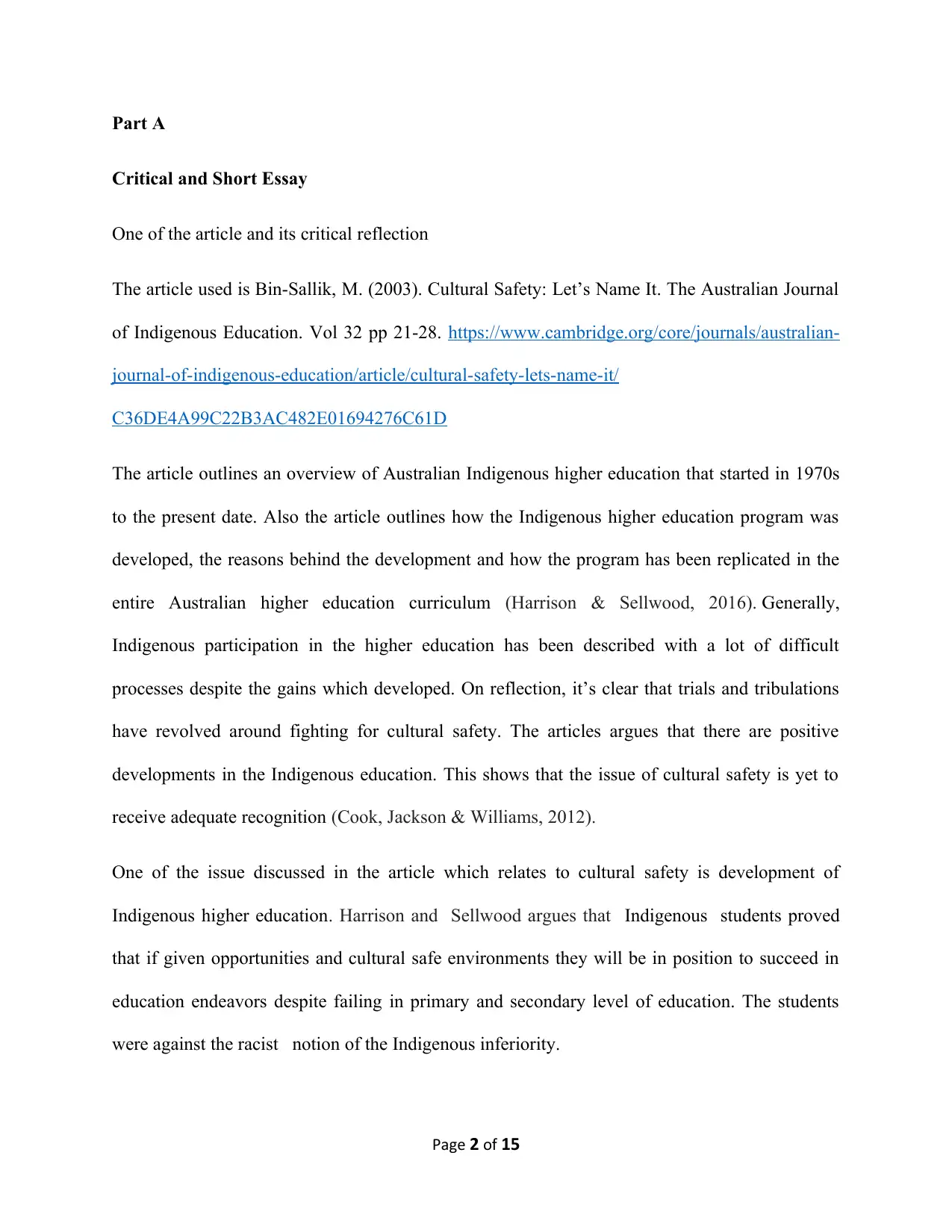
Part A
Critical and Short Essay
One of the article and its critical reflection
The article used is Bin-Sallik, M. (2003). Cultural Safety: Let’s Name It. The Australian Journal
of Indigenous Education. Vol 32 pp 21-28. https://www.cambridge.org/core/journals/australian-
journal-of-indigenous-education/article/cultural-safety-lets-name-it/
C36DE4A99C22B3AC482E01694276C61D
The article outlines an overview of Australian Indigenous higher education that started in 1970s
to the present date. Also the article outlines how the Indigenous higher education program was
developed, the reasons behind the development and how the program has been replicated in the
entire Australian higher education curriculum (Harrison & Sellwood, 2016). Generally,
Indigenous participation in the higher education has been described with a lot of difficult
processes despite the gains which developed. On reflection, it’s clear that trials and tribulations
have revolved around fighting for cultural safety. The articles argues that there are positive
developments in the Indigenous education. This shows that the issue of cultural safety is yet to
receive adequate recognition (Cook, Jackson & Williams, 2012).
One of the issue discussed in the article which relates to cultural safety is development of
Indigenous higher education. Harrison and Sellwood argues that Indigenous students proved
that if given opportunities and cultural safe environments they will be in position to succeed in
education endeavors despite failing in primary and secondary level of education. The students
were against the racist notion of the Indigenous inferiority.
Page 2 of 15
Critical and Short Essay
One of the article and its critical reflection
The article used is Bin-Sallik, M. (2003). Cultural Safety: Let’s Name It. The Australian Journal
of Indigenous Education. Vol 32 pp 21-28. https://www.cambridge.org/core/journals/australian-
journal-of-indigenous-education/article/cultural-safety-lets-name-it/
C36DE4A99C22B3AC482E01694276C61D
The article outlines an overview of Australian Indigenous higher education that started in 1970s
to the present date. Also the article outlines how the Indigenous higher education program was
developed, the reasons behind the development and how the program has been replicated in the
entire Australian higher education curriculum (Harrison & Sellwood, 2016). Generally,
Indigenous participation in the higher education has been described with a lot of difficult
processes despite the gains which developed. On reflection, it’s clear that trials and tribulations
have revolved around fighting for cultural safety. The articles argues that there are positive
developments in the Indigenous education. This shows that the issue of cultural safety is yet to
receive adequate recognition (Cook, Jackson & Williams, 2012).
One of the issue discussed in the article which relates to cultural safety is development of
Indigenous higher education. Harrison and Sellwood argues that Indigenous students proved
that if given opportunities and cultural safe environments they will be in position to succeed in
education endeavors despite failing in primary and secondary level of education. The students
were against the racist notion of the Indigenous inferiority.
Page 2 of 15
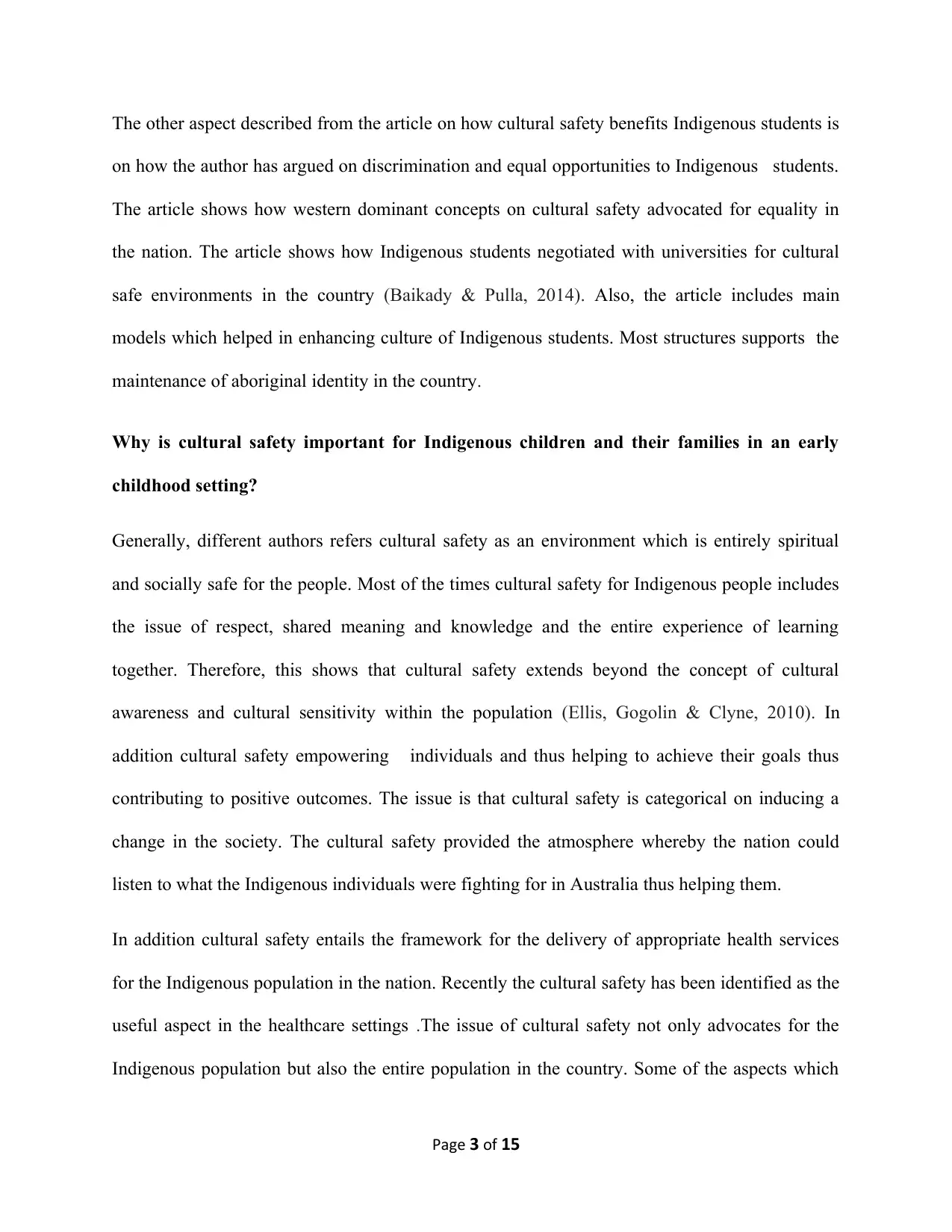
The other aspect described from the article on how cultural safety benefits Indigenous students is
on how the author has argued on discrimination and equal opportunities to Indigenous students.
The article shows how western dominant concepts on cultural safety advocated for equality in
the nation. The article shows how Indigenous students negotiated with universities for cultural
safe environments in the country (Baikady & Pulla, 2014). Also, the article includes main
models which helped in enhancing culture of Indigenous students. Most structures supports the
maintenance of aboriginal identity in the country.
Why is cultural safety important for Indigenous children and their families in an early
childhood setting?
Generally, different authors refers cultural safety as an environment which is entirely spiritual
and socially safe for the people. Most of the times cultural safety for Indigenous people includes
the issue of respect, shared meaning and knowledge and the entire experience of learning
together. Therefore, this shows that cultural safety extends beyond the concept of cultural
awareness and cultural sensitivity within the population (Ellis, Gogolin & Clyne, 2010). In
addition cultural safety empowering individuals and thus helping to achieve their goals thus
contributing to positive outcomes. The issue is that cultural safety is categorical on inducing a
change in the society. The cultural safety provided the atmosphere whereby the nation could
listen to what the Indigenous individuals were fighting for in Australia thus helping them.
In addition cultural safety entails the framework for the delivery of appropriate health services
for the Indigenous population in the nation. Recently the cultural safety has been identified as the
useful aspect in the healthcare settings .The issue of cultural safety not only advocates for the
Indigenous population but also the entire population in the country. Some of the aspects which
Page 3 of 15
on how the author has argued on discrimination and equal opportunities to Indigenous students.
The article shows how western dominant concepts on cultural safety advocated for equality in
the nation. The article shows how Indigenous students negotiated with universities for cultural
safe environments in the country (Baikady & Pulla, 2014). Also, the article includes main
models which helped in enhancing culture of Indigenous students. Most structures supports the
maintenance of aboriginal identity in the country.
Why is cultural safety important for Indigenous children and their families in an early
childhood setting?
Generally, different authors refers cultural safety as an environment which is entirely spiritual
and socially safe for the people. Most of the times cultural safety for Indigenous people includes
the issue of respect, shared meaning and knowledge and the entire experience of learning
together. Therefore, this shows that cultural safety extends beyond the concept of cultural
awareness and cultural sensitivity within the population (Ellis, Gogolin & Clyne, 2010). In
addition cultural safety empowering individuals and thus helping to achieve their goals thus
contributing to positive outcomes. The issue is that cultural safety is categorical on inducing a
change in the society. The cultural safety provided the atmosphere whereby the nation could
listen to what the Indigenous individuals were fighting for in Australia thus helping them.
In addition cultural safety entails the framework for the delivery of appropriate health services
for the Indigenous population in the nation. Recently the cultural safety has been identified as the
useful aspect in the healthcare settings .The issue of cultural safety not only advocates for the
Indigenous population but also the entire population in the country. Some of the aspects which
Page 3 of 15
⊘ This is a preview!⊘
Do you want full access?
Subscribe today to unlock all pages.

Trusted by 1+ million students worldwide
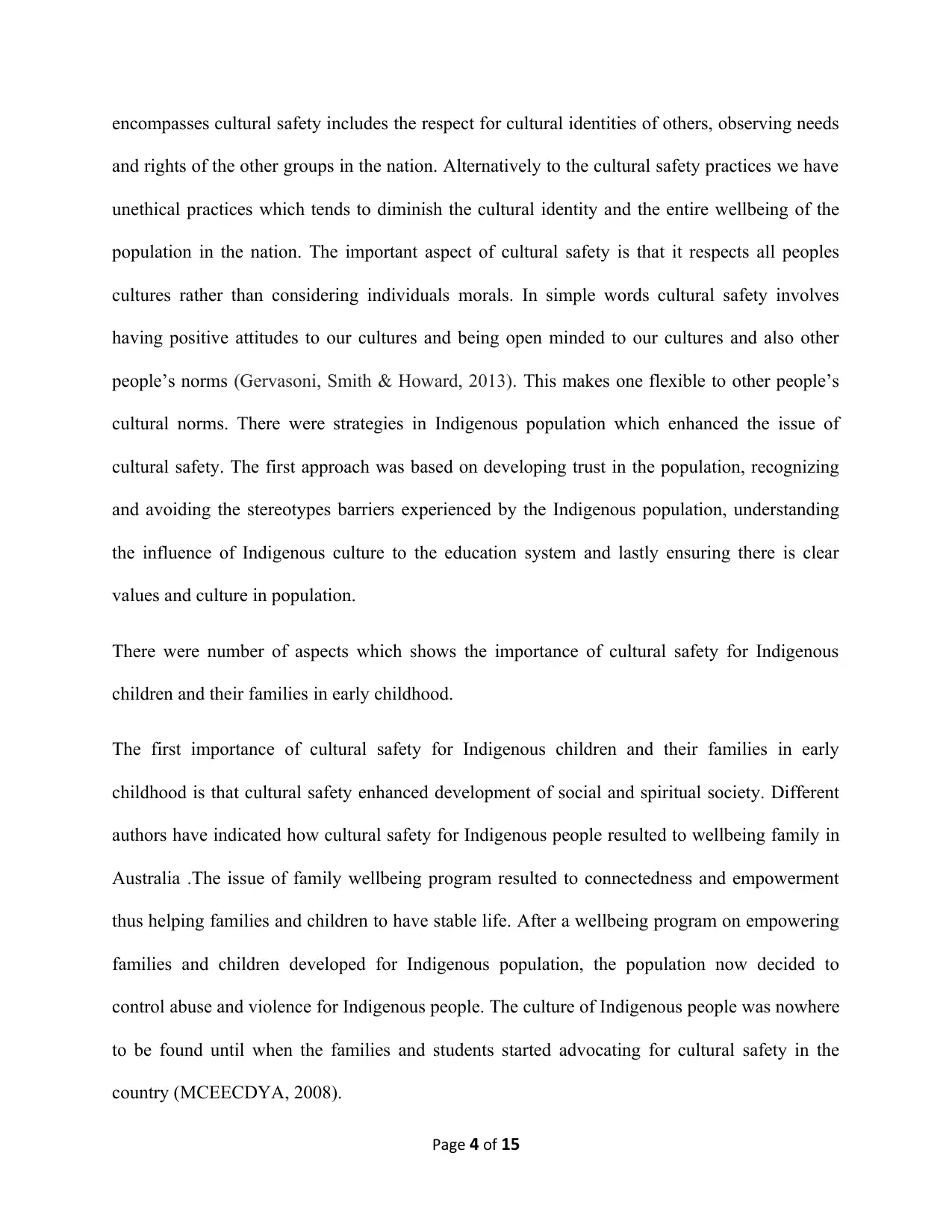
encompasses cultural safety includes the respect for cultural identities of others, observing needs
and rights of the other groups in the nation. Alternatively to the cultural safety practices we have
unethical practices which tends to diminish the cultural identity and the entire wellbeing of the
population in the nation. The important aspect of cultural safety is that it respects all peoples
cultures rather than considering individuals morals. In simple words cultural safety involves
having positive attitudes to our cultures and being open minded to our cultures and also other
people’s norms (Gervasoni, Smith & Howard, 2013). This makes one flexible to other people’s
cultural norms. There were strategies in Indigenous population which enhanced the issue of
cultural safety. The first approach was based on developing trust in the population, recognizing
and avoiding the stereotypes barriers experienced by the Indigenous population, understanding
the influence of Indigenous culture to the education system and lastly ensuring there is clear
values and culture in population.
There were number of aspects which shows the importance of cultural safety for Indigenous
children and their families in early childhood.
The first importance of cultural safety for Indigenous children and their families in early
childhood is that cultural safety enhanced development of social and spiritual society. Different
authors have indicated how cultural safety for Indigenous people resulted to wellbeing family in
Australia .The issue of family wellbeing program resulted to connectedness and empowerment
thus helping families and children to have stable life. After a wellbeing program on empowering
families and children developed for Indigenous population, the population now decided to
control abuse and violence for Indigenous people. The culture of Indigenous people was nowhere
to be found until when the families and students started advocating for cultural safety in the
country (MCEECDYA, 2008).
Page 4 of 15
and rights of the other groups in the nation. Alternatively to the cultural safety practices we have
unethical practices which tends to diminish the cultural identity and the entire wellbeing of the
population in the nation. The important aspect of cultural safety is that it respects all peoples
cultures rather than considering individuals morals. In simple words cultural safety involves
having positive attitudes to our cultures and being open minded to our cultures and also other
people’s norms (Gervasoni, Smith & Howard, 2013). This makes one flexible to other people’s
cultural norms. There were strategies in Indigenous population which enhanced the issue of
cultural safety. The first approach was based on developing trust in the population, recognizing
and avoiding the stereotypes barriers experienced by the Indigenous population, understanding
the influence of Indigenous culture to the education system and lastly ensuring there is clear
values and culture in population.
There were number of aspects which shows the importance of cultural safety for Indigenous
children and their families in early childhood.
The first importance of cultural safety for Indigenous children and their families in early
childhood is that cultural safety enhanced development of social and spiritual society. Different
authors have indicated how cultural safety for Indigenous people resulted to wellbeing family in
Australia .The issue of family wellbeing program resulted to connectedness and empowerment
thus helping families and children to have stable life. After a wellbeing program on empowering
families and children developed for Indigenous population, the population now decided to
control abuse and violence for Indigenous people. The culture of Indigenous people was nowhere
to be found until when the families and students started advocating for cultural safety in the
country (MCEECDYA, 2008).
Page 4 of 15
Paraphrase This Document
Need a fresh take? Get an instant paraphrase of this document with our AI Paraphraser
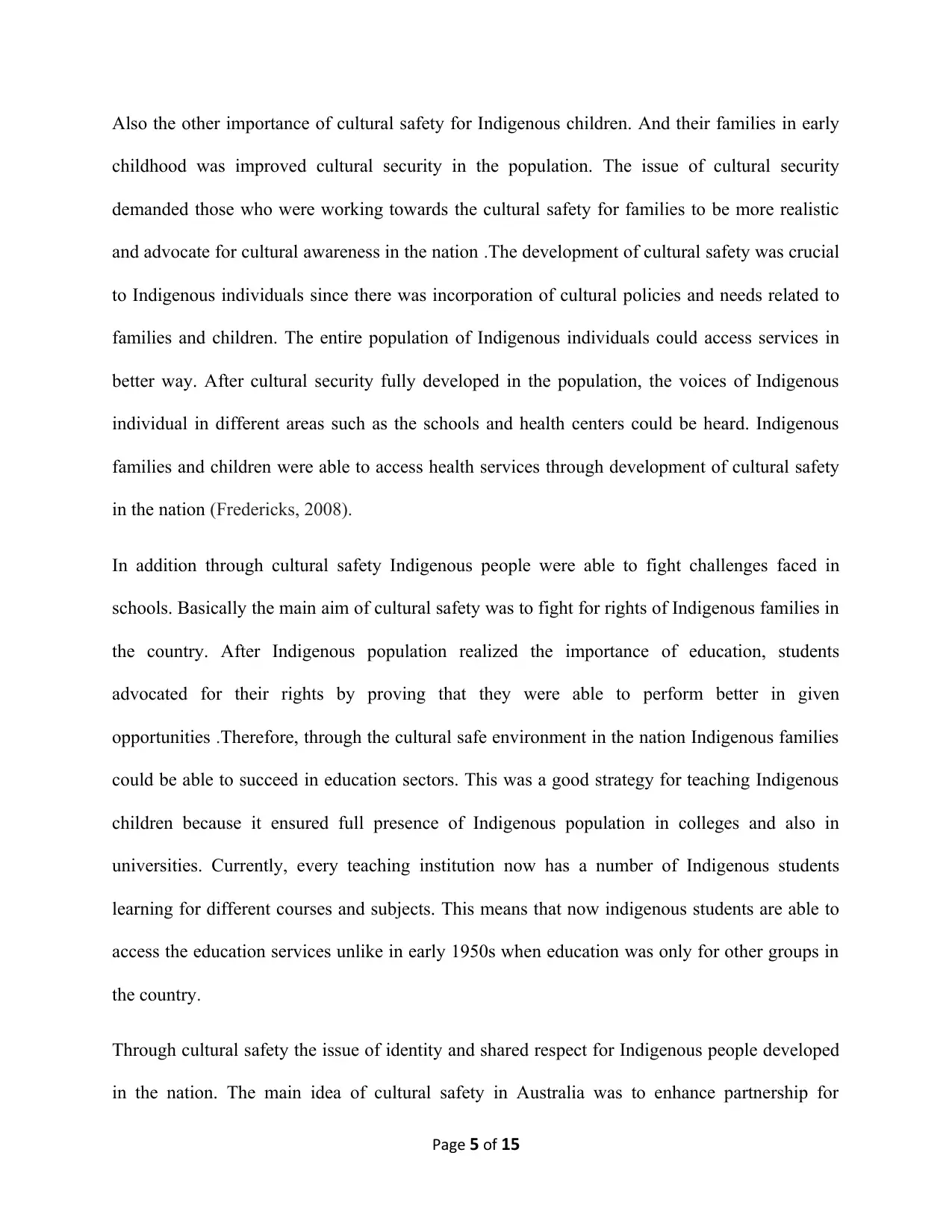
Also the other importance of cultural safety for Indigenous children. And their families in early
childhood was improved cultural security in the population. The issue of cultural security
demanded those who were working towards the cultural safety for families to be more realistic
and advocate for cultural awareness in the nation .The development of cultural safety was crucial
to Indigenous individuals since there was incorporation of cultural policies and needs related to
families and children. The entire population of Indigenous individuals could access services in
better way. After cultural security fully developed in the population, the voices of Indigenous
individual in different areas such as the schools and health centers could be heard. Indigenous
families and children were able to access health services through development of cultural safety
in the nation (Fredericks, 2008).
In addition through cultural safety Indigenous people were able to fight challenges faced in
schools. Basically the main aim of cultural safety was to fight for rights of Indigenous families in
the country. After Indigenous population realized the importance of education, students
advocated for their rights by proving that they were able to perform better in given
opportunities .Therefore, through the cultural safe environment in the nation Indigenous families
could be able to succeed in education sectors. This was a good strategy for teaching Indigenous
children because it ensured full presence of Indigenous population in colleges and also in
universities. Currently, every teaching institution now has a number of Indigenous students
learning for different courses and subjects. This means that now indigenous students are able to
access the education services unlike in early 1950s when education was only for other groups in
the country.
Through cultural safety the issue of identity and shared respect for Indigenous people developed
in the nation. The main idea of cultural safety in Australia was to enhance partnership for
Page 5 of 15
childhood was improved cultural security in the population. The issue of cultural security
demanded those who were working towards the cultural safety for families to be more realistic
and advocate for cultural awareness in the nation .The development of cultural safety was crucial
to Indigenous individuals since there was incorporation of cultural policies and needs related to
families and children. The entire population of Indigenous individuals could access services in
better way. After cultural security fully developed in the population, the voices of Indigenous
individual in different areas such as the schools and health centers could be heard. Indigenous
families and children were able to access health services through development of cultural safety
in the nation (Fredericks, 2008).
In addition through cultural safety Indigenous people were able to fight challenges faced in
schools. Basically the main aim of cultural safety was to fight for rights of Indigenous families in
the country. After Indigenous population realized the importance of education, students
advocated for their rights by proving that they were able to perform better in given
opportunities .Therefore, through the cultural safe environment in the nation Indigenous families
could be able to succeed in education sectors. This was a good strategy for teaching Indigenous
children because it ensured full presence of Indigenous population in colleges and also in
universities. Currently, every teaching institution now has a number of Indigenous students
learning for different courses and subjects. This means that now indigenous students are able to
access the education services unlike in early 1950s when education was only for other groups in
the country.
Through cultural safety the issue of identity and shared respect for Indigenous people developed
in the nation. The main idea of cultural safety in Australia was to enhance partnership for
Page 5 of 15
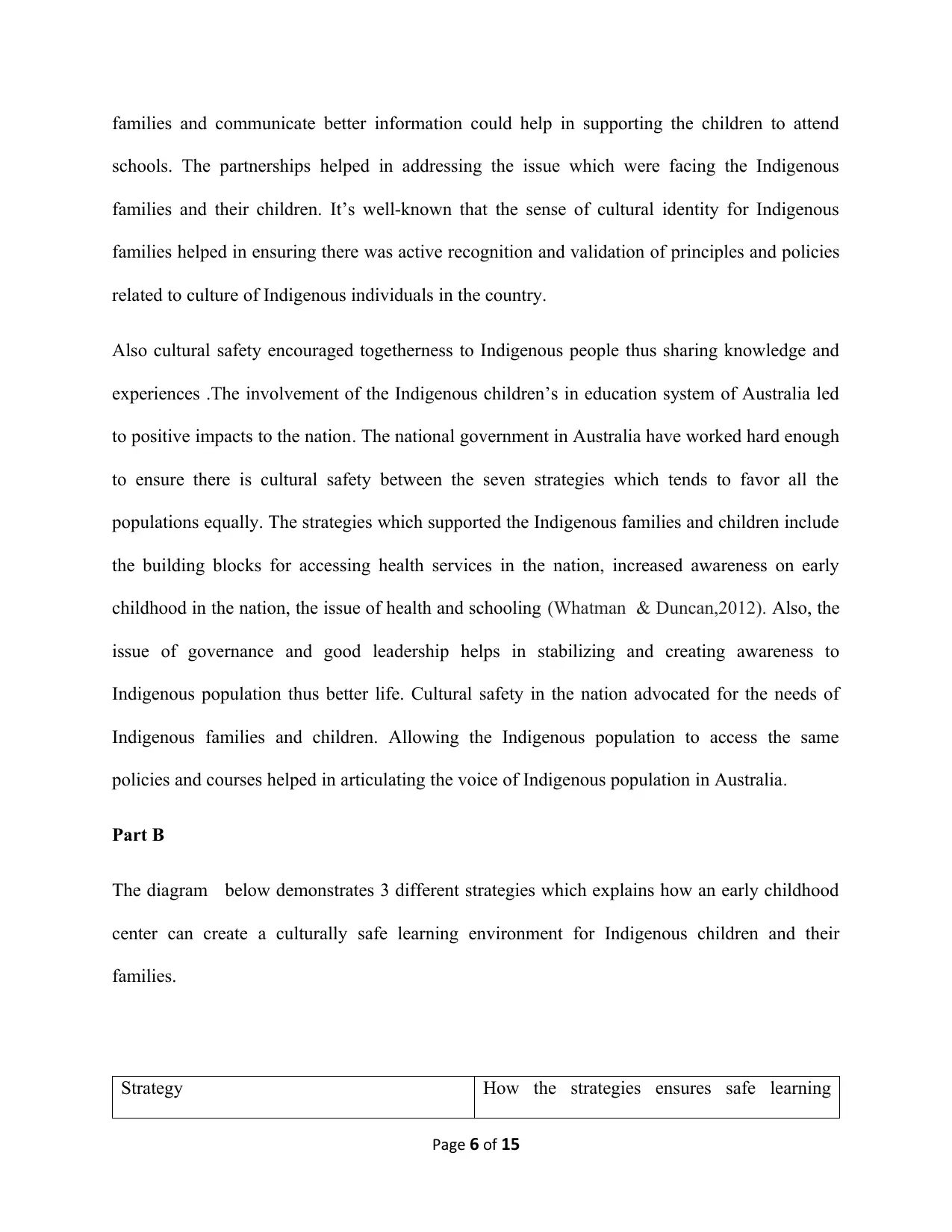
families and communicate better information could help in supporting the children to attend
schools. The partnerships helped in addressing the issue which were facing the Indigenous
families and their children. It’s well-known that the sense of cultural identity for Indigenous
families helped in ensuring there was active recognition and validation of principles and policies
related to culture of Indigenous individuals in the country.
Also cultural safety encouraged togetherness to Indigenous people thus sharing knowledge and
experiences .The involvement of the Indigenous children’s in education system of Australia led
to positive impacts to the nation. The national government in Australia have worked hard enough
to ensure there is cultural safety between the seven strategies which tends to favor all the
populations equally. The strategies which supported the Indigenous families and children include
the building blocks for accessing health services in the nation, increased awareness on early
childhood in the nation, the issue of health and schooling (Whatman & Duncan,2012). Also, the
issue of governance and good leadership helps in stabilizing and creating awareness to
Indigenous population thus better life. Cultural safety in the nation advocated for the needs of
Indigenous families and children. Allowing the Indigenous population to access the same
policies and courses helped in articulating the voice of Indigenous population in Australia.
Part B
The diagram below demonstrates 3 different strategies which explains how an early childhood
center can create a culturally safe learning environment for Indigenous children and their
families.
Strategy How the strategies ensures safe learning
Page 6 of 15
schools. The partnerships helped in addressing the issue which were facing the Indigenous
families and their children. It’s well-known that the sense of cultural identity for Indigenous
families helped in ensuring there was active recognition and validation of principles and policies
related to culture of Indigenous individuals in the country.
Also cultural safety encouraged togetherness to Indigenous people thus sharing knowledge and
experiences .The involvement of the Indigenous children’s in education system of Australia led
to positive impacts to the nation. The national government in Australia have worked hard enough
to ensure there is cultural safety between the seven strategies which tends to favor all the
populations equally. The strategies which supported the Indigenous families and children include
the building blocks for accessing health services in the nation, increased awareness on early
childhood in the nation, the issue of health and schooling (Whatman & Duncan,2012). Also, the
issue of governance and good leadership helps in stabilizing and creating awareness to
Indigenous population thus better life. Cultural safety in the nation advocated for the needs of
Indigenous families and children. Allowing the Indigenous population to access the same
policies and courses helped in articulating the voice of Indigenous population in Australia.
Part B
The diagram below demonstrates 3 different strategies which explains how an early childhood
center can create a culturally safe learning environment for Indigenous children and their
families.
Strategy How the strategies ensures safe learning
Page 6 of 15
⊘ This is a preview!⊘
Do you want full access?
Subscribe today to unlock all pages.

Trusted by 1+ million students worldwide
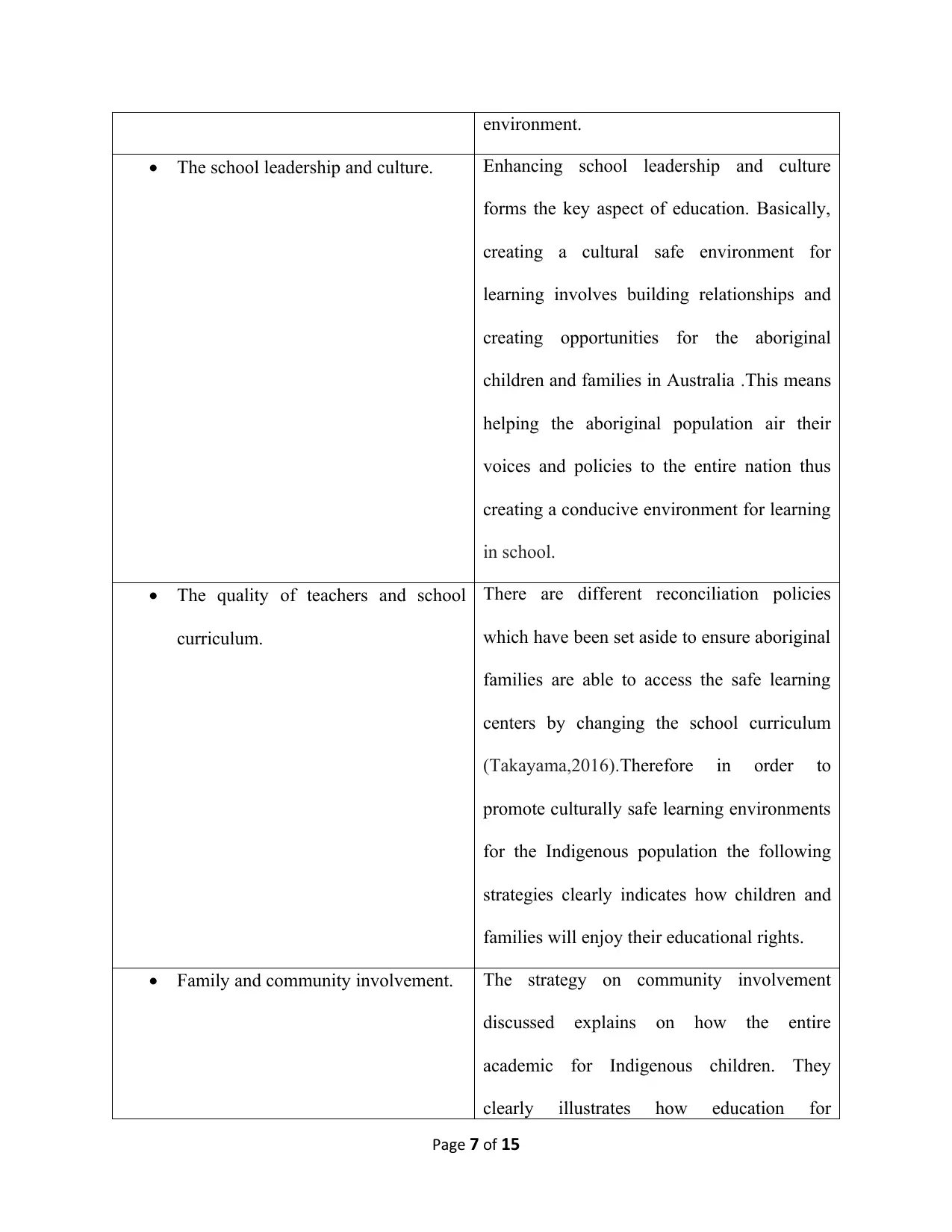
environment.
The school leadership and culture. Enhancing school leadership and culture
forms the key aspect of education. Basically,
creating a cultural safe environment for
learning involves building relationships and
creating opportunities for the aboriginal
children and families in Australia .This means
helping the aboriginal population air their
voices and policies to the entire nation thus
creating a conducive environment for learning
in school.
The quality of teachers and school
curriculum.
There are different reconciliation policies
which have been set aside to ensure aboriginal
families are able to access the safe learning
centers by changing the school curriculum
(Takayama,2016).Therefore in order to
promote culturally safe learning environments
for the Indigenous population the following
strategies clearly indicates how children and
families will enjoy their educational rights.
Family and community involvement. The strategy on community involvement
discussed explains on how the entire
academic for Indigenous children. They
clearly illustrates how education for
Page 7 of 15
The school leadership and culture. Enhancing school leadership and culture
forms the key aspect of education. Basically,
creating a cultural safe environment for
learning involves building relationships and
creating opportunities for the aboriginal
children and families in Australia .This means
helping the aboriginal population air their
voices and policies to the entire nation thus
creating a conducive environment for learning
in school.
The quality of teachers and school
curriculum.
There are different reconciliation policies
which have been set aside to ensure aboriginal
families are able to access the safe learning
centers by changing the school curriculum
(Takayama,2016).Therefore in order to
promote culturally safe learning environments
for the Indigenous population the following
strategies clearly indicates how children and
families will enjoy their educational rights.
Family and community involvement. The strategy on community involvement
discussed explains on how the entire
academic for Indigenous children. They
clearly illustrates how education for
Page 7 of 15
Paraphrase This Document
Need a fresh take? Get an instant paraphrase of this document with our AI Paraphraser
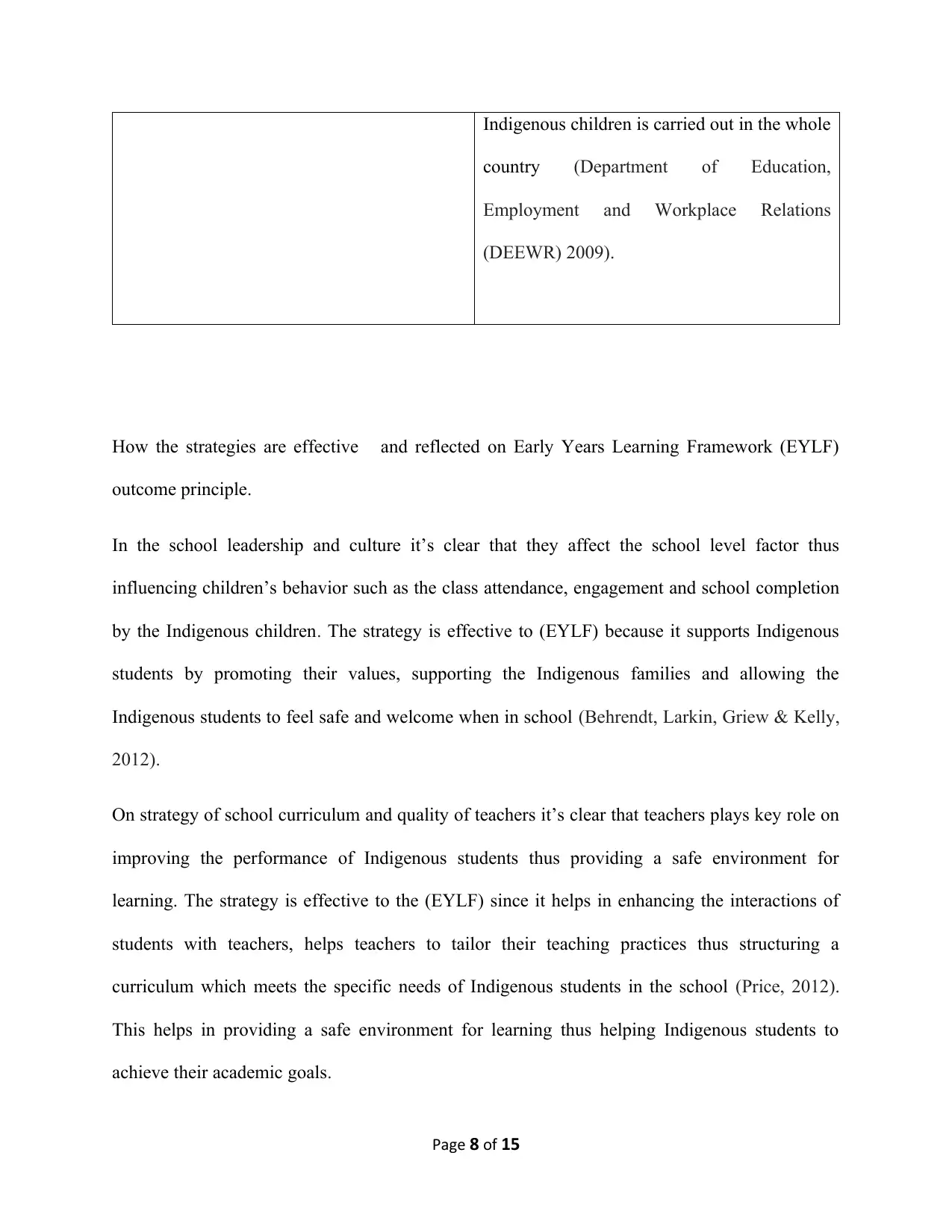
Indigenous children is carried out in the whole
country (Department of Education,
Employment and Workplace Relations
(DEEWR) 2009).
How the strategies are effective and reflected on Early Years Learning Framework (EYLF)
outcome principle.
In the school leadership and culture it’s clear that they affect the school level factor thus
influencing children’s behavior such as the class attendance, engagement and school completion
by the Indigenous children. The strategy is effective to (EYLF) because it supports Indigenous
students by promoting their values, supporting the Indigenous families and allowing the
Indigenous students to feel safe and welcome when in school (Behrendt, Larkin, Griew & Kelly,
2012).
On strategy of school curriculum and quality of teachers it’s clear that teachers plays key role on
improving the performance of Indigenous students thus providing a safe environment for
learning. The strategy is effective to the (EYLF) since it helps in enhancing the interactions of
students with teachers, helps teachers to tailor their teaching practices thus structuring a
curriculum which meets the specific needs of Indigenous students in the school (Price, 2012).
This helps in providing a safe environment for learning thus helping Indigenous students to
achieve their academic goals.
Page 8 of 15
country (Department of Education,
Employment and Workplace Relations
(DEEWR) 2009).
How the strategies are effective and reflected on Early Years Learning Framework (EYLF)
outcome principle.
In the school leadership and culture it’s clear that they affect the school level factor thus
influencing children’s behavior such as the class attendance, engagement and school completion
by the Indigenous children. The strategy is effective to (EYLF) because it supports Indigenous
students by promoting their values, supporting the Indigenous families and allowing the
Indigenous students to feel safe and welcome when in school (Behrendt, Larkin, Griew & Kelly,
2012).
On strategy of school curriculum and quality of teachers it’s clear that teachers plays key role on
improving the performance of Indigenous students thus providing a safe environment for
learning. The strategy is effective to the (EYLF) since it helps in enhancing the interactions of
students with teachers, helps teachers to tailor their teaching practices thus structuring a
curriculum which meets the specific needs of Indigenous students in the school (Price, 2012).
This helps in providing a safe environment for learning thus helping Indigenous students to
achieve their academic goals.
Page 8 of 15
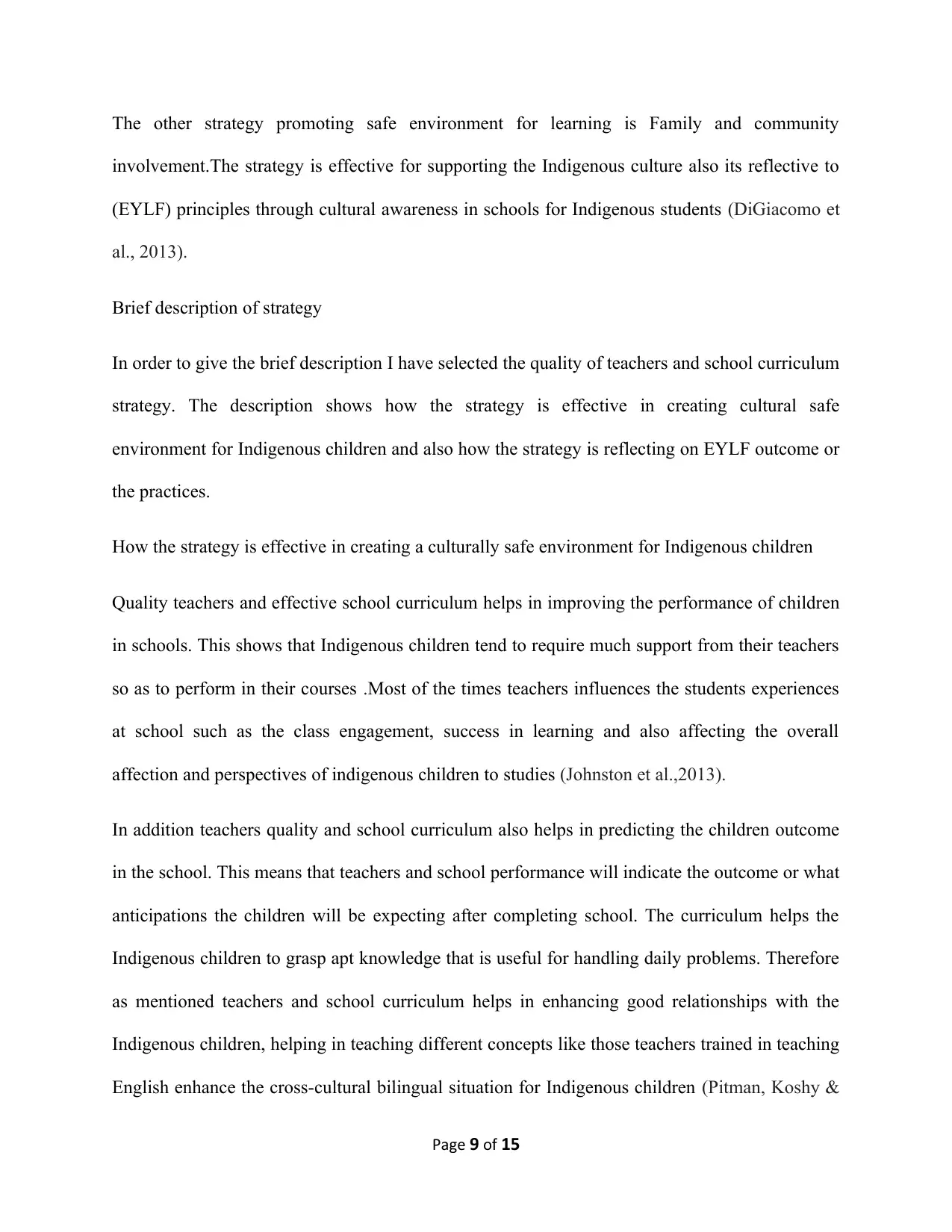
The other strategy promoting safe environment for learning is Family and community
involvement.The strategy is effective for supporting the Indigenous culture also its reflective to
(EYLF) principles through cultural awareness in schools for Indigenous students (DiGiacomo et
al., 2013).
Brief description of strategy
In order to give the brief description I have selected the quality of teachers and school curriculum
strategy. The description shows how the strategy is effective in creating cultural safe
environment for Indigenous children and also how the strategy is reflecting on EYLF outcome or
the practices.
How the strategy is effective in creating a culturally safe environment for Indigenous children
Quality teachers and effective school curriculum helps in improving the performance of children
in schools. This shows that Indigenous children tend to require much support from their teachers
so as to perform in their courses .Most of the times teachers influences the students experiences
at school such as the class engagement, success in learning and also affecting the overall
affection and perspectives of indigenous children to studies (Johnston et al.,2013).
In addition teachers quality and school curriculum also helps in predicting the children outcome
in the school. This means that teachers and school performance will indicate the outcome or what
anticipations the children will be expecting after completing school. The curriculum helps the
Indigenous children to grasp apt knowledge that is useful for handling daily problems. Therefore
as mentioned teachers and school curriculum helps in enhancing good relationships with the
Indigenous children, helping in teaching different concepts like those teachers trained in teaching
English enhance the cross-cultural bilingual situation for Indigenous children (Pitman, Koshy &
Page 9 of 15
involvement.The strategy is effective for supporting the Indigenous culture also its reflective to
(EYLF) principles through cultural awareness in schools for Indigenous students (DiGiacomo et
al., 2013).
Brief description of strategy
In order to give the brief description I have selected the quality of teachers and school curriculum
strategy. The description shows how the strategy is effective in creating cultural safe
environment for Indigenous children and also how the strategy is reflecting on EYLF outcome or
the practices.
How the strategy is effective in creating a culturally safe environment for Indigenous children
Quality teachers and effective school curriculum helps in improving the performance of children
in schools. This shows that Indigenous children tend to require much support from their teachers
so as to perform in their courses .Most of the times teachers influences the students experiences
at school such as the class engagement, success in learning and also affecting the overall
affection and perspectives of indigenous children to studies (Johnston et al.,2013).
In addition teachers quality and school curriculum also helps in predicting the children outcome
in the school. This means that teachers and school performance will indicate the outcome or what
anticipations the children will be expecting after completing school. The curriculum helps the
Indigenous children to grasp apt knowledge that is useful for handling daily problems. Therefore
as mentioned teachers and school curriculum helps in enhancing good relationships with the
Indigenous children, helping in teaching different concepts like those teachers trained in teaching
English enhance the cross-cultural bilingual situation for Indigenous children (Pitman, Koshy &
Page 9 of 15
⊘ This is a preview!⊘
Do you want full access?
Subscribe today to unlock all pages.

Trusted by 1+ million students worldwide
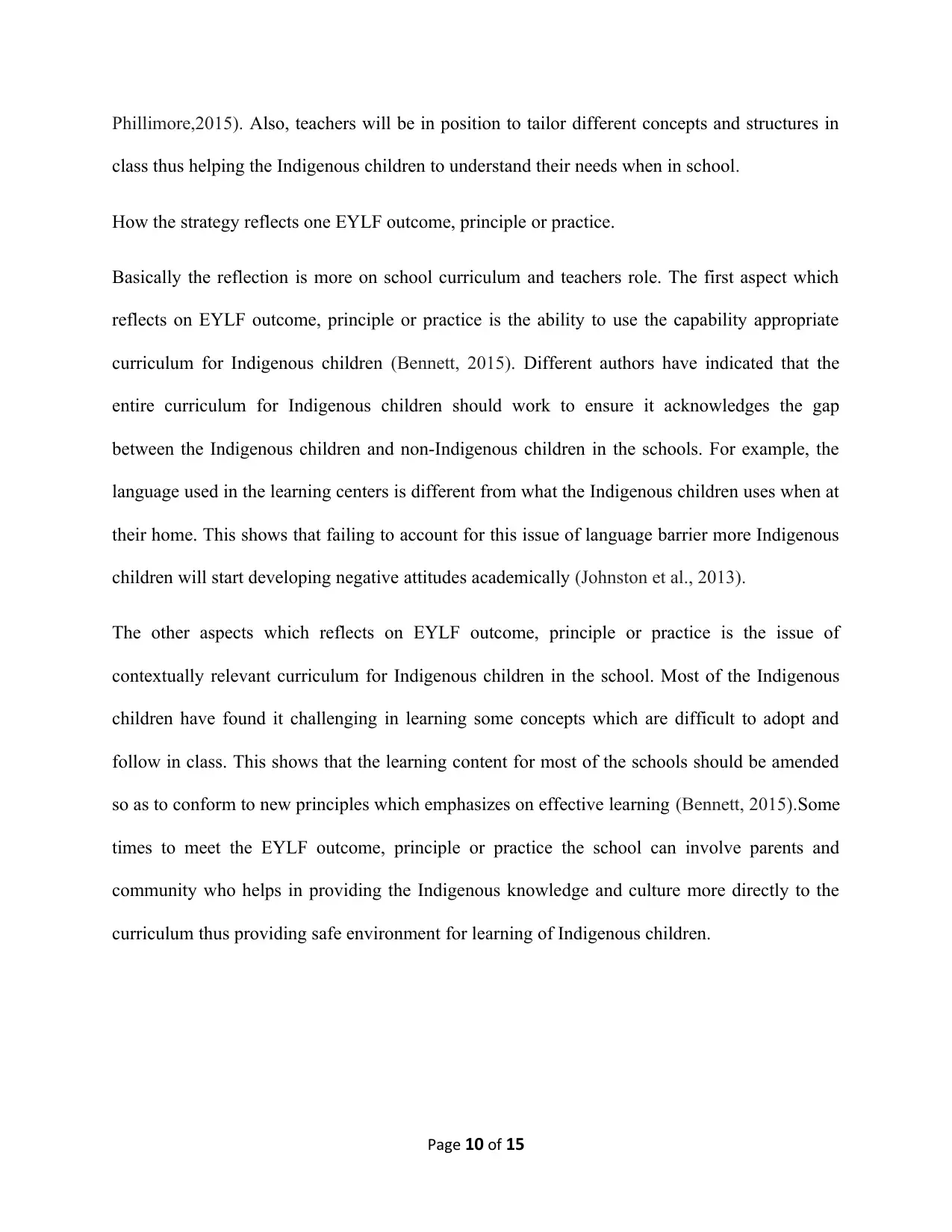
Phillimore,2015). Also, teachers will be in position to tailor different concepts and structures in
class thus helping the Indigenous children to understand their needs when in school.
How the strategy reflects one EYLF outcome, principle or practice.
Basically the reflection is more on school curriculum and teachers role. The first aspect which
reflects on EYLF outcome, principle or practice is the ability to use the capability appropriate
curriculum for Indigenous children (Bennett, 2015). Different authors have indicated that the
entire curriculum for Indigenous children should work to ensure it acknowledges the gap
between the Indigenous children and non-Indigenous children in the schools. For example, the
language used in the learning centers is different from what the Indigenous children uses when at
their home. This shows that failing to account for this issue of language barrier more Indigenous
children will start developing negative attitudes academically (Johnston et al., 2013).
The other aspects which reflects on EYLF outcome, principle or practice is the issue of
contextually relevant curriculum for Indigenous children in the school. Most of the Indigenous
children have found it challenging in learning some concepts which are difficult to adopt and
follow in class. This shows that the learning content for most of the schools should be amended
so as to conform to new principles which emphasizes on effective learning (Bennett, 2015).Some
times to meet the EYLF outcome, principle or practice the school can involve parents and
community who helps in providing the Indigenous knowledge and culture more directly to the
curriculum thus providing safe environment for learning of Indigenous children.
Page 10 of 15
class thus helping the Indigenous children to understand their needs when in school.
How the strategy reflects one EYLF outcome, principle or practice.
Basically the reflection is more on school curriculum and teachers role. The first aspect which
reflects on EYLF outcome, principle or practice is the ability to use the capability appropriate
curriculum for Indigenous children (Bennett, 2015). Different authors have indicated that the
entire curriculum for Indigenous children should work to ensure it acknowledges the gap
between the Indigenous children and non-Indigenous children in the schools. For example, the
language used in the learning centers is different from what the Indigenous children uses when at
their home. This shows that failing to account for this issue of language barrier more Indigenous
children will start developing negative attitudes academically (Johnston et al., 2013).
The other aspects which reflects on EYLF outcome, principle or practice is the issue of
contextually relevant curriculum for Indigenous children in the school. Most of the Indigenous
children have found it challenging in learning some concepts which are difficult to adopt and
follow in class. This shows that the learning content for most of the schools should be amended
so as to conform to new principles which emphasizes on effective learning (Bennett, 2015).Some
times to meet the EYLF outcome, principle or practice the school can involve parents and
community who helps in providing the Indigenous knowledge and culture more directly to the
curriculum thus providing safe environment for learning of Indigenous children.
Page 10 of 15
Paraphrase This Document
Need a fresh take? Get an instant paraphrase of this document with our AI Paraphraser
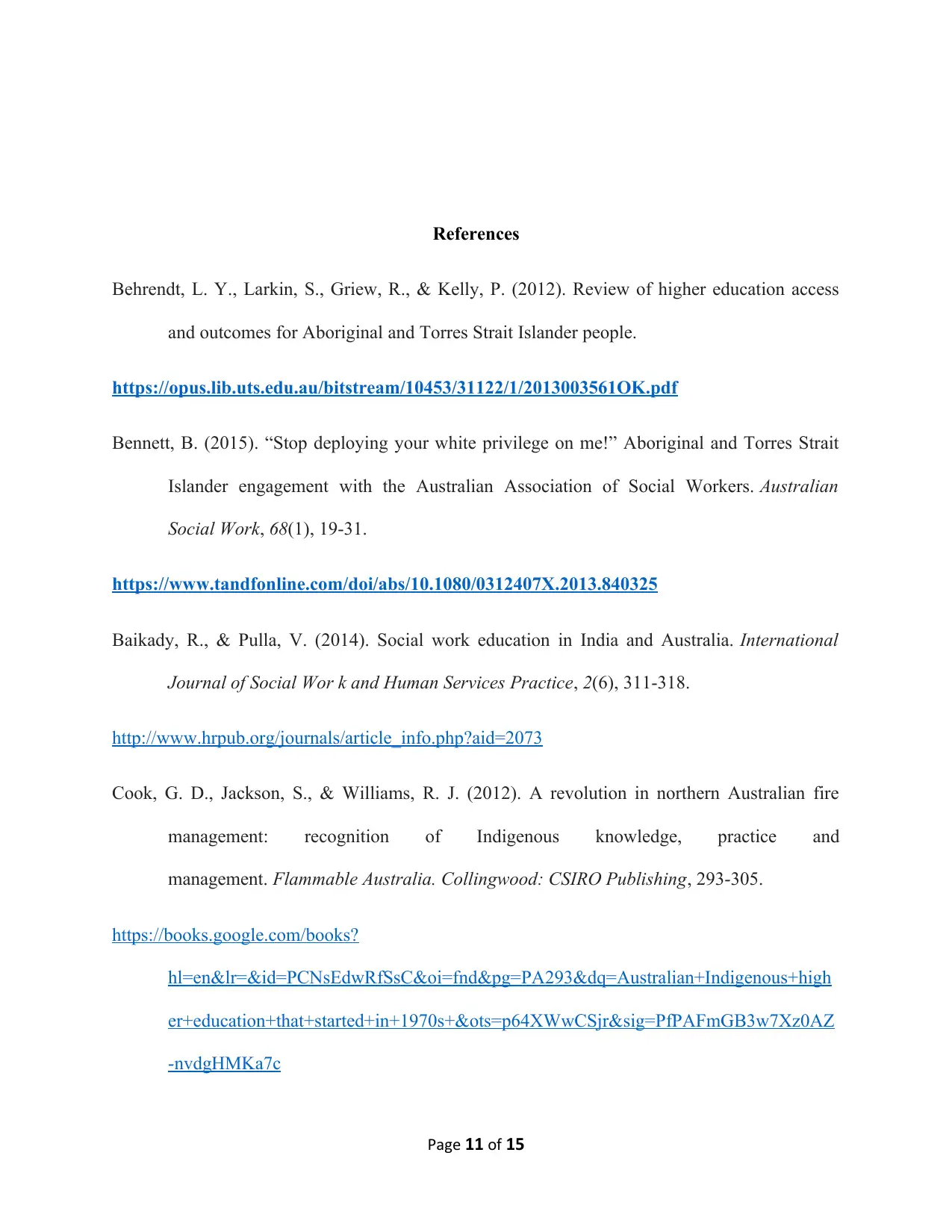
References
Behrendt, L. Y., Larkin, S., Griew, R., & Kelly, P. (2012). Review of higher education access
and outcomes for Aboriginal and Torres Strait Islander people.
https://opus.lib.uts.edu.au/bitstream/10453/31122/1/2013003561OK.pdf
Bennett, B. (2015). “Stop deploying your white privilege on me!” Aboriginal and Torres Strait
Islander engagement with the Australian Association of Social Workers. Australian
Social Work, 68(1), 19-31.
https://www.tandfonline.com/doi/abs/10.1080/0312407X.2013.840325
Baikady, R., & Pulla, V. (2014). Social work education in India and Australia. International
Journal of Social Wor k and Human Services Practice, 2(6), 311-318.
http://www.hrpub.org/journals/article_info.php?aid=2073
Cook, G. D., Jackson, S., & Williams, R. J. (2012). A revolution in northern Australian fire
management: recognition of Indigenous knowledge, practice and
management. Flammable Australia. Collingwood: CSIRO Publishing, 293-305.
https://books.google.com/books?
hl=en&lr=&id=PCNsEdwRfSsC&oi=fnd&pg=PA293&dq=Australian+Indigenous+high
er+education+that+started+in+1970s+&ots=p64XWwCSjr&sig=PfPAFmGB3w7Xz0AZ
-nvdgHMKa7c
Page 11 of 15
Behrendt, L. Y., Larkin, S., Griew, R., & Kelly, P. (2012). Review of higher education access
and outcomes for Aboriginal and Torres Strait Islander people.
https://opus.lib.uts.edu.au/bitstream/10453/31122/1/2013003561OK.pdf
Bennett, B. (2015). “Stop deploying your white privilege on me!” Aboriginal and Torres Strait
Islander engagement with the Australian Association of Social Workers. Australian
Social Work, 68(1), 19-31.
https://www.tandfonline.com/doi/abs/10.1080/0312407X.2013.840325
Baikady, R., & Pulla, V. (2014). Social work education in India and Australia. International
Journal of Social Wor k and Human Services Practice, 2(6), 311-318.
http://www.hrpub.org/journals/article_info.php?aid=2073
Cook, G. D., Jackson, S., & Williams, R. J. (2012). A revolution in northern Australian fire
management: recognition of Indigenous knowledge, practice and
management. Flammable Australia. Collingwood: CSIRO Publishing, 293-305.
https://books.google.com/books?
hl=en&lr=&id=PCNsEdwRfSsC&oi=fnd&pg=PA293&dq=Australian+Indigenous+high
er+education+that+started+in+1970s+&ots=p64XWwCSjr&sig=PfPAFmGB3w7Xz0AZ
-nvdgHMKa7c
Page 11 of 15
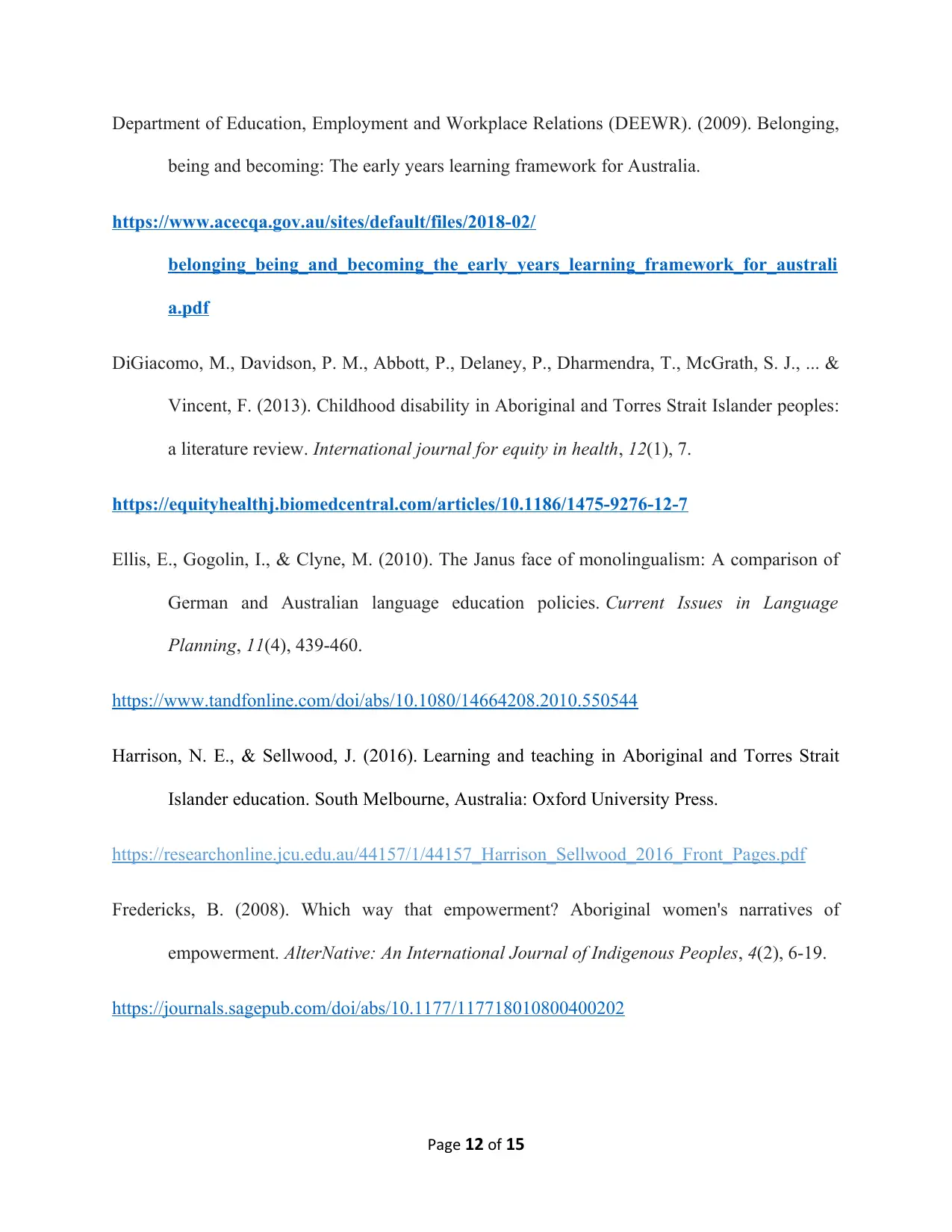
Department of Education, Employment and Workplace Relations (DEEWR). (2009). Belonging,
being and becoming: The early years learning framework for Australia.
https://www.acecqa.gov.au/sites/default/files/2018-02/
belonging_being_and_becoming_the_early_years_learning_framework_for_australi
a.pdf
DiGiacomo, M., Davidson, P. M., Abbott, P., Delaney, P., Dharmendra, T., McGrath, S. J., ... &
Vincent, F. (2013). Childhood disability in Aboriginal and Torres Strait Islander peoples:
a literature review. International journal for equity in health, 12(1), 7.
https://equityhealthj.biomedcentral.com/articles/10.1186/1475-9276-12-7
Ellis, E., Gogolin, I., & Clyne, M. (2010). The Janus face of monolingualism: A comparison of
German and Australian language education policies. Current Issues in Language
Planning, 11(4), 439-460.
https://www.tandfonline.com/doi/abs/10.1080/14664208.2010.550544
Harrison, N. E., & Sellwood, J. (2016). Learning and teaching in Aboriginal and Torres Strait
Islander education. South Melbourne, Australia: Oxford University Press.
https://researchonline.jcu.edu.au/44157/1/44157_Harrison_Sellwood_2016_Front_Pages.pdf
Fredericks, B. (2008). Which way that empowerment? Aboriginal women's narratives of
empowerment. AlterNative: An International Journal of Indigenous Peoples, 4(2), 6-19.
https://journals.sagepub.com/doi/abs/10.1177/117718010800400202
Page 12 of 15
being and becoming: The early years learning framework for Australia.
https://www.acecqa.gov.au/sites/default/files/2018-02/
belonging_being_and_becoming_the_early_years_learning_framework_for_australi
a.pdf
DiGiacomo, M., Davidson, P. M., Abbott, P., Delaney, P., Dharmendra, T., McGrath, S. J., ... &
Vincent, F. (2013). Childhood disability in Aboriginal and Torres Strait Islander peoples:
a literature review. International journal for equity in health, 12(1), 7.
https://equityhealthj.biomedcentral.com/articles/10.1186/1475-9276-12-7
Ellis, E., Gogolin, I., & Clyne, M. (2010). The Janus face of monolingualism: A comparison of
German and Australian language education policies. Current Issues in Language
Planning, 11(4), 439-460.
https://www.tandfonline.com/doi/abs/10.1080/14664208.2010.550544
Harrison, N. E., & Sellwood, J. (2016). Learning and teaching in Aboriginal and Torres Strait
Islander education. South Melbourne, Australia: Oxford University Press.
https://researchonline.jcu.edu.au/44157/1/44157_Harrison_Sellwood_2016_Front_Pages.pdf
Fredericks, B. (2008). Which way that empowerment? Aboriginal women's narratives of
empowerment. AlterNative: An International Journal of Indigenous Peoples, 4(2), 6-19.
https://journals.sagepub.com/doi/abs/10.1177/117718010800400202
Page 12 of 15
⊘ This is a preview!⊘
Do you want full access?
Subscribe today to unlock all pages.

Trusted by 1+ million students worldwide
1 out of 15
Related Documents
Your All-in-One AI-Powered Toolkit for Academic Success.
+13062052269
info@desklib.com
Available 24*7 on WhatsApp / Email
![[object Object]](/_next/static/media/star-bottom.7253800d.svg)
Unlock your academic potential
Copyright © 2020–2025 A2Z Services. All Rights Reserved. Developed and managed by ZUCOL.





